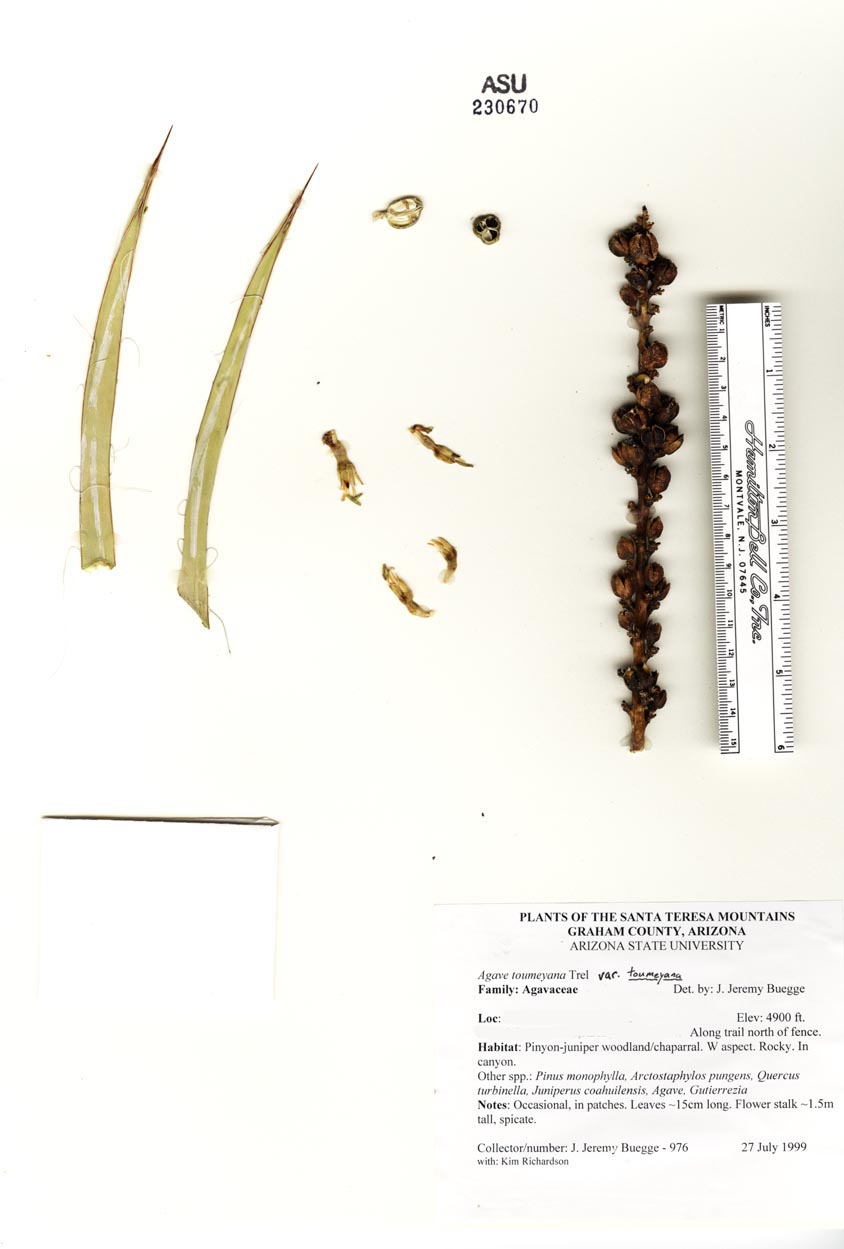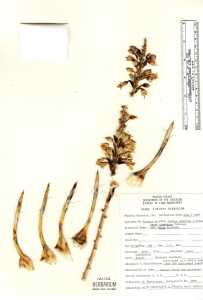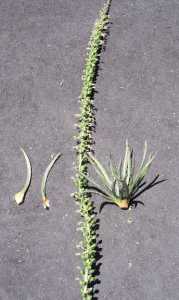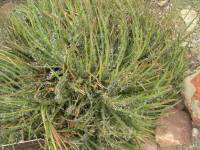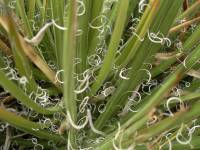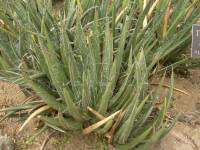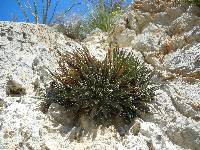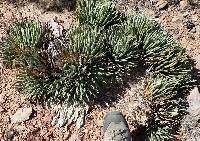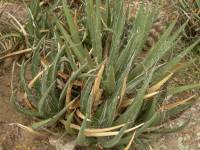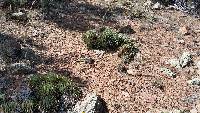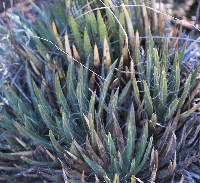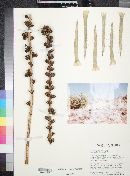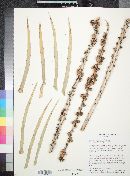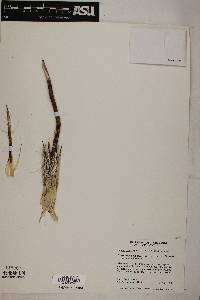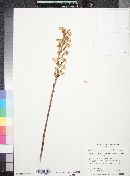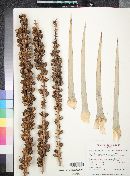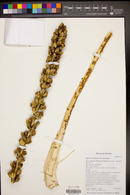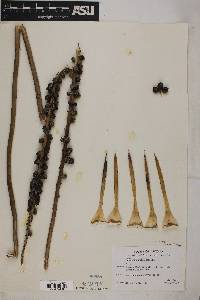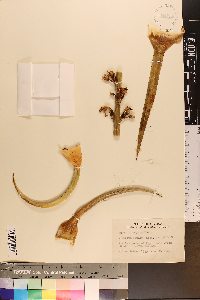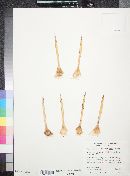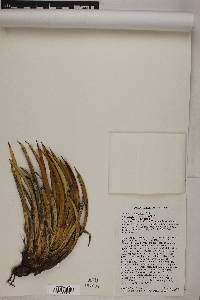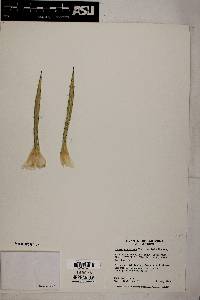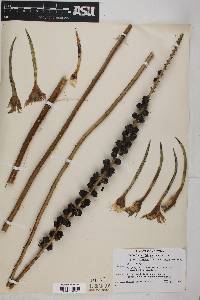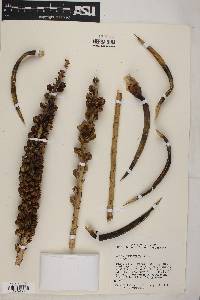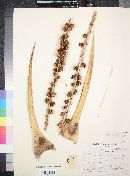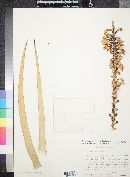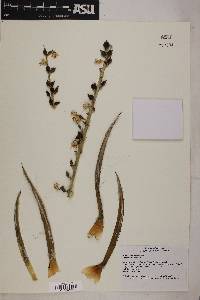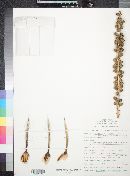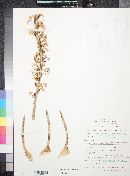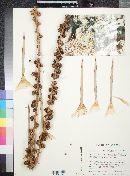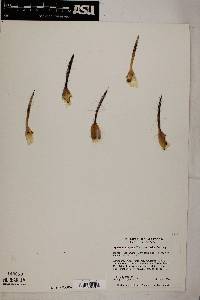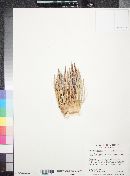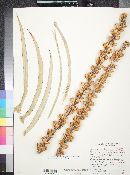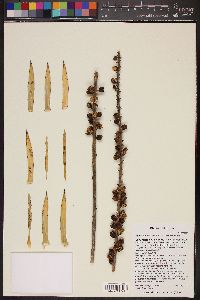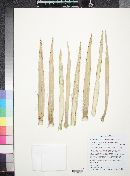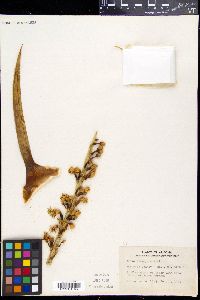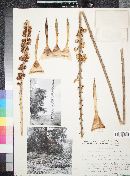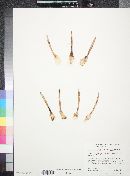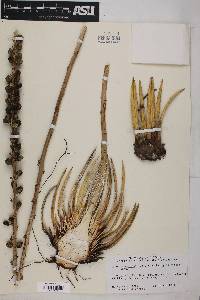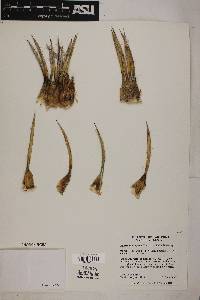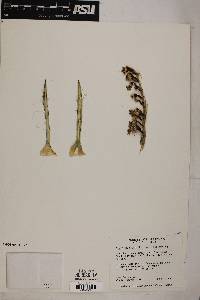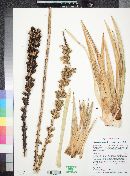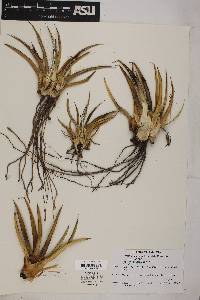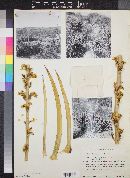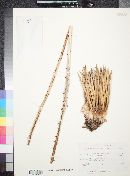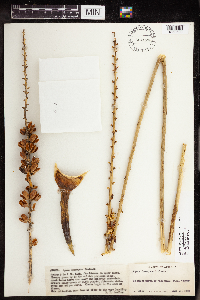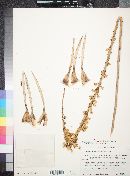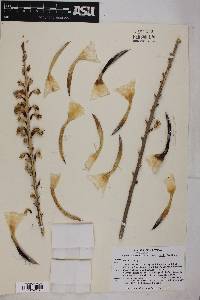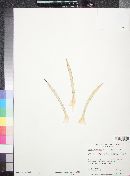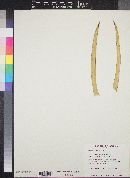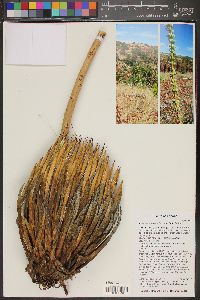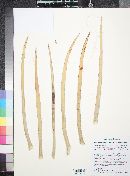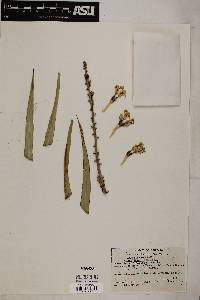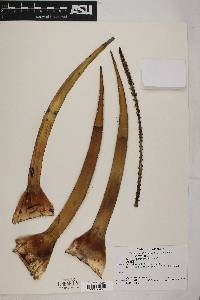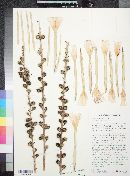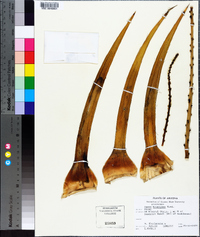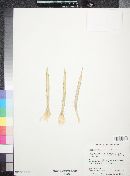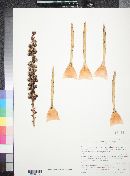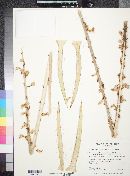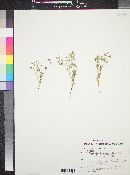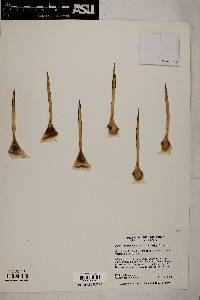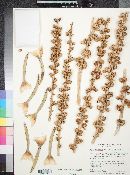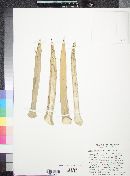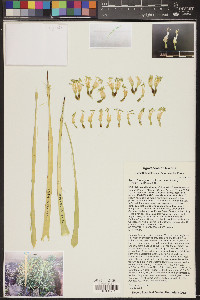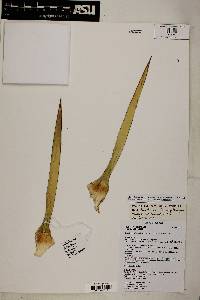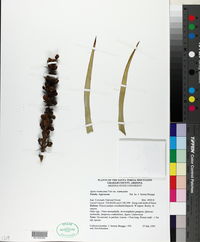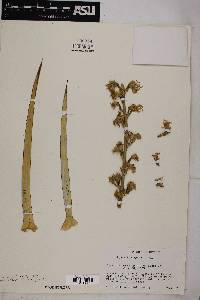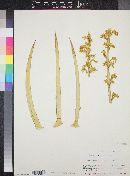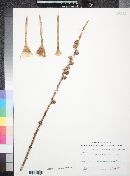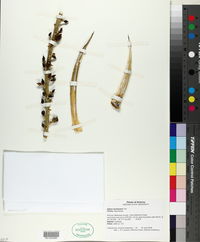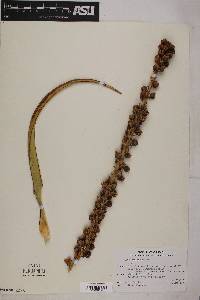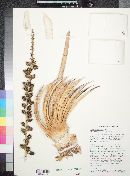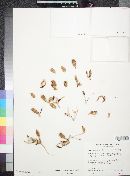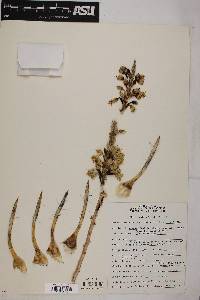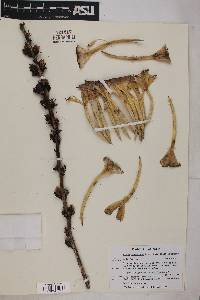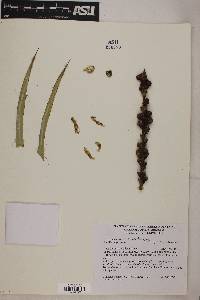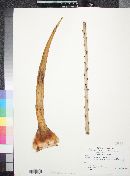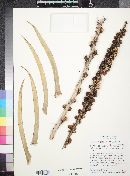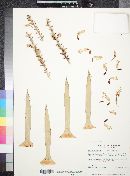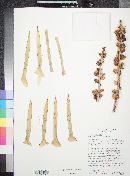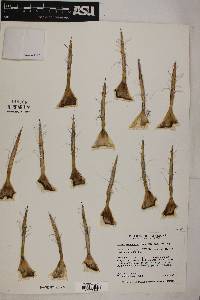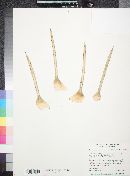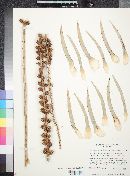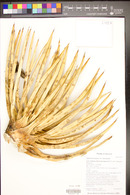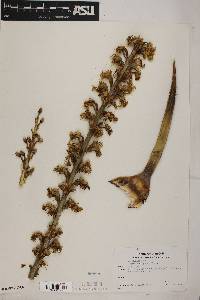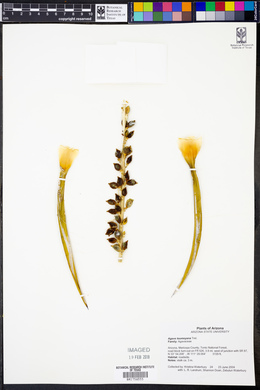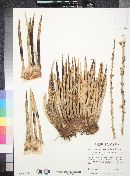
|
|
|
|
Family: Asparagaceae
Toumey's century plant, more...Toumey's Century-Plant, Toumey agave
|
Plants acaulescent, freely suckering; rosettes densely cespitose, (0.3-)1-5 × 1.5-6 dm. Leaves ascending to erect, (3-)9-46 × 0.5-2 cm; blade light green to yellowish green or dark green with white bud-prints on both surfaces, linear to linear-lanceolate, firm, adaxially plane toward apex, abaxially convex toward base; margins straight, infrequently denticulate, filiferous, fibers conspicuous, white, curled, infrequently sparse or absent, teeth sparse or absent, in proximal 1/2 of blade or near base; apex acute to long-acuminate, spine brown to grayish, subulate to filiform, 0.6-2 cm. Scape 1.5-3 m. Inflorescences spicate, laxly to rather densely flowered on distal 1/3; bracts caducous, linear-triangular, 1-3.5 cm; peduncle 5 mm or shorter. Flowers 1 or 2, slightly recurved, 1.6-2.8 cm; perianth greenish white, tube campanulate, 3-4.5 × 6-10 mm, limb lobes erect to incurved, subequal, 6.5-10 mm; stamens slightly exserted; filaments inserted 1-3.5 mm above base of perianth tube, erect, white, 1.1-1.7 cm; anthers pale yellow, 7-16 mm; ovary 0.8-1.6 cm, neck slightly constricted, 3-7 mm. Capsules sessile, oblong, 0.9-1.5 cm, apex short-beaked. Seeds 2.5-3 mm. Both varieties hybridize with Agave chrysantha.
Plant: perennial scapose herb; Rosettes (3-)10-50 cm high, 15-60 cm wide, densely caespitose Leaves: several to numerous, 8.5-46 cm long, 0.6-2.4 cm wide, linear to linear-lanceolate, straight, falcate, or upcurving, planar towards apex, thickly convex towards base, rather rigid, light green to yellowish-green to dark green, bud-imprinted above and below; margins with a fine brown margin and white threadlike fibers, sometimes serrulate at base or denticulate - down leaf to base; spine 0.6-2 cm long, subulate to filiform, with a short narrow groove above, brown to gray INFLORESCENCE: with scape 1.5-3 m tall, subspicate, laxly or densely flowered in upper - of flowering stalk, the stalk slender, green or red Flowers: generally in pairs on short pedicels, 16-28 mm long, flexed downward, fragrance not discernable; tepals subequal, 7-10 mm long, 2.25-4 mm wide, cream to light chartreuse green, clasping the filaments; filaments 11-16 mm long, inserted 1-3.5 mm above base of tube, white, the anthers 7-13 mm long, yellow-cream; ovary 8-16 mm long with constricted, angled neck 3-7 mm long, cream-green, the style 18-24 mm long when stigma is receptive; floral tube 3-4.5 mm high, 6-10 mm wide, angled, cream-green Fruit: capsules, 9-15 mm long, 9-10 mm wide, sessile, short-beaked; SEEDS 3 mm long, 2 mm wide, thickish Misc: -Open rocky, often limestone or basalt slopes of desert scrub, chaparral, and pinon-juniper woodland REFERENCES: Hodgson, Wendy. 1999. Agavaceae. Ariz. - Nev. Acad. Sci. 32(1). FNA 2003 Common Name: Toumey's century plant Duration: Perennial Nativity: Native Lifeform: Succulent General: Perennial scapose succulents, Plants without stems, rosettes in dense clusters with spines protruding at shin height, 10-50 cm across and 15-60 cm tall. Leaves: Light to dark green with bud-prints on both upper and lower surfaces, 9-45 cm long and 0.5-2 cm wide, margins with white, curling fibers, lightly armed near the base or unarmed. Flowers: Panicle on stem 1.5-3 m, loosely to densely flowered with flowers arranged in a spike on the distal 1/3 of the scape. Bracts linear to triangular in shape and not persistent. Flowers borne on a short stalk in groups of 1-2, 1.6-2.8 cm in length, bell-shaped, flowers greenish-white, stamens slightly exserted, filaments white, inserted up to 3.5 mm above the base of the tube, anthers pale yellow. Fruits: Capsules oblong, 1-1.5 cm long, sessile, apex short-beaked. Ecology: Found on limestone or basalt slopes in gravelly or rocky areas of desert scrub, chaparral, and pi-on-juniper woodlands, from 2,000-5,000 ft (610-1524 m); flowers late spring-summer. Notes: There are 2 varieties of A. toumeyana in the southwest, var. toumeyana and var. bella. These are differentiated by the number of leaves and the leaf form, with var. toumeyana having 40-70 leaves per mature rosette, denticulate only near the base, and var. bella having 100-200 leaves per mature rosette, and denticulate below the mid-leaf. A. toumeyana and its varieties are thought to hybridize with Agave chrysantha, making positive identification difficult. Ethnobotany: Specific use of species unknown, but uses for the genus include using the whole plant as food, and leaves as fiber to make clothing, tools, rope, and sandals. Etymology: Agave is from Greek agauos, admirable, noble, while toumeyana is named for James W. Toumey (1865-1932) a botanist and professor at the University of Arizona. Synonyms: None Editor: LCrumbacher, 2011 |
|
|
|
This project was made possible in part by the Institute of Museum and Library Services [MG-70-19-0057-19].
Powered by Symbiota

